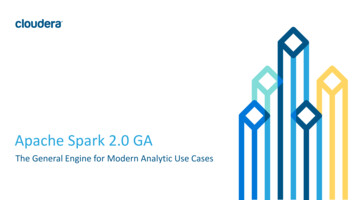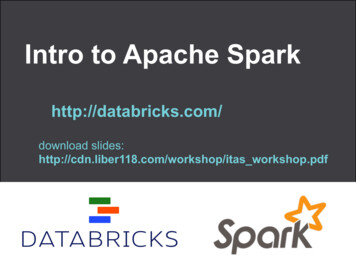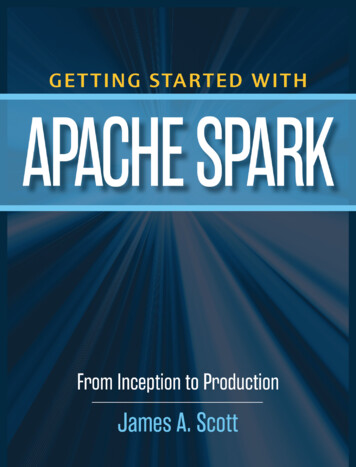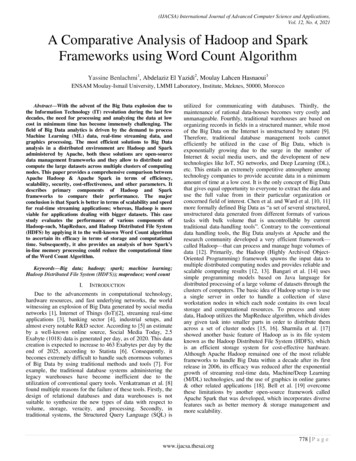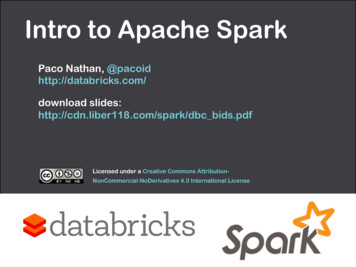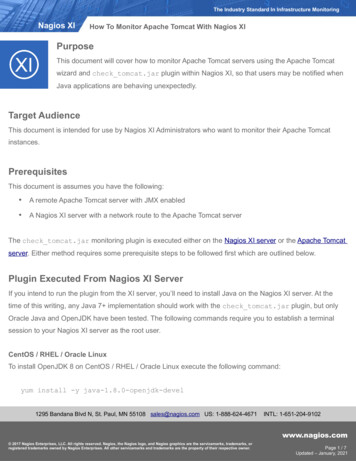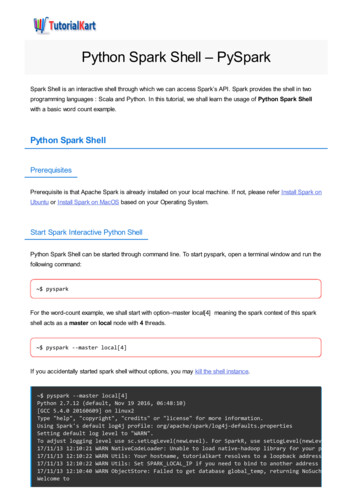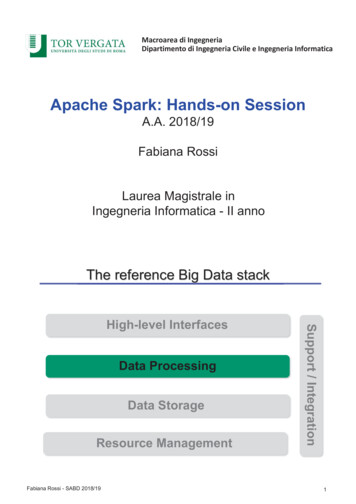
Transcription
Macroarea di IngegneriaDipartimento di Ingegneria Civile e Ingegneria InformaticaApache Spark: Hands-on SessionA.A. 2018/19Fabiana RossiLaurea Magistrale inIngegneria Informatica - II annoThe reference Big Data stackData ProcessingData StorageResource ManagementFabiana Rossi - SABD 2018/19Support / IntegrationHigh-level Interfaces1
Main reference for this lectureH.Karau, A. Konwinski, P. Wendell, M. Zaharia,"Learning Spark"O'Reilly Media, 2015.Fabiana Rossi - SABD 2018/192Java 8: Lambda Expressions You're usually trying to pass functionality as anargument to another method– e.g., what action should be taken when someone clicks abutton Lambda expressions enable to treat functionalityas method argument, or code as dataFabiana Rossi - SABD 2018/193
Java 8: Lambda ExpressionsExample: a social networking application. You want to create a feature that enables an administrator toperform any kind of action, such as sending a message, onmembers of the social networking application that satisfy certaincriteriaSuppose that members ofthis social networkingapplication arerepresented by thefollowing Person class:public class Person {public enum Sex { MALE, FEMALE }String name;LocalDate birthday;Sex gender;String emailAddress;public int getAge() { . }public void printPerson() { . }}Fabiana Rossi - SABD 2018/194Java 8: Lambda Expressions Suppose that the members of your social networking applicationare stored in a List instanceApproach 1: Create Methods That Search for Members That MatchOne Characteristicpublic static void invitePersons(List Person roster,int age){for (Person p : roster) {if (p.getAge() age) {p.sendMessage();}}}Fabiana Rossi - SABD 2018/195
Java 8: Lambda ExpressionsApproach 2: Specify Search Criteria Code in a Local Classpublic static void invitePersons(List Person roster,CheckPerson tester){for (Person p : roster) {if (tester.test(p)) { p.sendMessage(); }}}interface CheckPerson {boolean test(Person p);}class CheckEligiblePerson implements CheckPerson {public boolean test(Person p) {return p.getAge() 18 && p.getAge() 25;}}Fabiana Rossi - SABD 2018/196Java 8: Lambda ExpressionsApproach 3: Specify Search Criteria Code in an Anonymous ClassinvitePersons(roster,new CheckPerson() {public boolean test(Person p) {return p.getAge() 18 && p.getAge() 25;}});Approach 4: Specify Search Criteria Code with a Lambda ExpressioninvitePersons(roster,(Person p) - p.getAge() 18 && p.getAge() 25);Fabiana Rossi - SABD 2018/197
Apache SparkFabiana Rossi - SABD 2018/19Spark Cluster Spark applications run as independent sets of processeson a cluster, coordinated by the SparkContext object in aSpark program (called the driver program).Cluster Manager Types Standalone: a simple cluster manager included with Spark Apache Mesos Hadoop YARNFabiana Rossi - SABD 2018/199
Spark programming model Spark programming model is based on parallelizableoperators Parallelizable operators are higher-order functionsthat execute user-defined functions in parallel A data flow is composed of any number of datasources, operators, and data sinks by connectingtheir inputs and outputs Job description based on DAGFabiana Rossi - SABD 2018/1910Resilient Distributed Dataset (RDD) The primary abstraction in Spark: a distributedmemory abstraction Immutable, partitioned collection of elements– Like a LinkedList MyObjects – Operated on in parallel– Cached in memory across the cluster nodes Each node of the cluster that is used to run an applicationcontains at least one partition of the RDD(s) that is (are)defined in the applicationFabiana Rossi - SABD 2018/1911
Resilient Distributed Dataset (RDD) Spark programs are written in terms ofoperations on RDDs RDDs built and manipulated through:– Coarse-grained transformations Map, filter, join, – Actions Count, collect, save, Fabiana Rossi - SABD 2018/1912Spark and RDDs Spark manages scheduling andsynchronization of the jobs Manages the split of RDDs in partitions andallocates RDDs’ partitions in the nodes of thecluster Hides complexities of fault-tolerance and slowmachines RDDs are automatically rebuilt in case ofmachine failureFabiana Rossi - SABD 2018/1913
Spark and RDDsFabiana Rossi - SABD 2018/1914Spark Cluster You can start a standalone master server by executing: SPARK HOME/sbin/start-master.sh(on master node) Similarly, you can start one or more workers and connectthem to the master via: SPARK HOME/sbin/start-slave.sh master-spark-URL (on slave nodes) It is also possible to start slaves from the master node:# Starts a slave instance on each machine specified#in the conf/slaves file on the master node SPARK HOME/sbin/start-slaves.sh(on master node) Spark has a WebUI reachable at http://localhost:8080Fabiana Rossi - SABD 2018/1915
Spark Cluster You can stop the master server by executing: SPARK HOME/sbin/stop-master.sh(on master node) Similarly, you can stop a worker via: SPARK HOME/sbin/stop-slave.sh(on slave nodes) It is also possible to stop slaves from the master node:# Starts a slave instance on each machine specified#in the conf/slaves file on the master node SPARK HOME/sbin/stop-slaves.sh(on master node)Fabiana Rossi - SABD 2018/1916Spark: Launching Applications ./bin/spark-submit \--class main-class \--master master-url \[--conf key value ] \ application-jar \[application-arguments]--class: The entry point for your application (e.g. package.WordCount)--master: The master URL for the clustere.g., "local", "spark://HOST:PORT", "mesos://HOST:PORT"--conf: Arbitrary Spark configuration propertyapplication-jar: Path to a bundled jar including your application andall dependencies.application-arguments: Arguments passed to the main method ofyour main class, if anyFabiana Rossi - SABD 2018/1917
How to create RDDs RDD can be created by:– Parallelizing existing collections of the hostingprogramming language (e.g., collections and lists ofScala, Java, Python, or R) Number of partitions specified by user API: parallelize– From (large) files stored in HDFS or any other filesystem One partition per HDFS block API: textFile– By transforming an existing RDD Number of partitions depends on transformation type API: transformation operations (map, filter, flatMap)Fabiana Rossi - SABD 2018/1918How to create RDDsż parallelize: Turn a collection into an RDDż textFile: Load text file from local file system,HDFS, or S3Fabiana Rossi - SABD 2018/1919
Operations over RDDTransformations Create a new dataset from and existing one.Lazy in nature. They are executed only when some action isperformed.Example: map(), filter(), distinct()Actions Returns to the driver program a value or exports data to a storagesystem after performing a computation.Example: count(), reduce(), collect()Persistence For caching datasets in-memory for future operations. Option tostore on disk or RAM or mixed.Functions: persist(), cache()Fabiana Rossi - SABD 2018/1920Operations over RDD: TransformationsFabiana Rossi - SABD 2018/1921
Operations over RDD: TransformationsFabiana Rossi - SABD 2018/1922Operations over RDD: Actions Actions are synchronousThey trigger execution of RDD transformations to return valuesUntil no action is fired, the data to be processed is not evenaccessedOnly actions can materialize the entire process with real dataCause data to be returned to driver or saved to outputFabiana Rossi - SABD 2018/1923
Operations over RDD: ActionsFabiana Rossi - SABD 2018/1924Operations over RDD: PersistenceSpark RDDs are lazily evaluated, and sometimes we may wish to usethe same RDD multiple times. Spark will recompute the RDD eachtime we call an action on it. This can be expensiveTo avoid computing an RDD multiple times, we can ask Spark topersist the data. Caching is the key tool for iterative algorithms.persist()can specify the Storage Level for persisting an RDD;some of the Storage Levels are: MEMORY ONLY, MEMORY AND DISK, DISK ONLYcache()is just a shortcut for persist(StorageLevel.MEMORY ONLY)Fabiana Rossi - SABD 2018/1925
Transformationsmap() The map() transformation takes in a function and applies it to eachelement in the RDD with the result of the function being the newvalue of each element in the resulting RDD.filter() The filter() transformation takes in a function and returns an RDDthat only has elements that pass the filter() function. We can use map() to do any number of things, from fetching thewebsite associated with each URL in our collection to just squaringthe numbers. Makes easy to implement the filter pattern in MapReduceExample: Square even numbersFabiana Rossi - SABD 2018/1926Example: Square Even Numberspublic class SquareEvenNumbers {public static void main(String[] args){SparkConf conf new SparkConf().setAppName("Square Even Number");JavaSparkContext sc new JavaSparkContext(conf);JavaRDD Integer input sc.parallelize(Arrays.asList(1, 2, 3, 4, 5, 6));JavaRDD Integer evenNumbers input.filter(x - (x % 2 0));JavaRDD Integer squaredEvenNumbers evenNumbers.map(x - x * x);for (Integer i : ;sc.stop();}}Fabiana Rossi - SABD 2018/19This is only an excerpt27
TransformationsflatMap()Sometimes we want to produce multiple output elements for eachinput element. The operation to do this is called flatMap().Fabiana Rossi - SABD 2018/1928Actionsreduce()This action takes a function that operates on two elements of the type inyour RDD and returns a new element of the same type.The function should be associative so that it can be computed inparallel.a (b c) (a b) cUseful to sum, multiply, count, and aggregate the elements of a RDD.Example (in Python): Sum all elementslines # Dstream with numbersnums lines.map(lambda x : int(x))sum nums nums.reduce(lambda x, y: x y)Fabiana Rossi - SABD 2018/1929
ActionsreduceByKey()When called on (K, V) pairs, return a new RDD of (K, V) pairs, wherethe values for each key are aggregated using the given reduce function Observe that, when implementing the function, we do not have tocare about the keyExample: Word Countpublic class WordCount {private static final Pattern SPACE Pattern.compile(" ");public static void main(String[] args){SparkConf conf [.]JavaSparkContext sc new JavaSparkContext(conf);JavaRDD String input [.]Fabiana Rossi - SABD 2018/19This is only an excerpt30Example: Word Count// We create a RDD of words by splitting a line of textJavaRDD String words input.flatMap(line - Arrays.asList(SPACE.split(line)).iterator());// We create the pair word, 1 to count elements using// the number summarization patternJavaPairRDD String, Integer pairs words.mapToPair(word - new Tuple2 (word, 1));// We reduce the elements by key (i.e., word) and countJavaPairRDD String, Integer counts pairs.reduceByKey((x, y) - x abiana Rossi - SABD 2018/19This is only an excerpt31
TransformationsPseudoset operationsRDDs support many of the operations of mathematical sets, such asunion and intersection, even when the RDDs themselves are notproperly setsFabiana Rossi - SABD 2018/1932TransformationsSample()extracts a subset of the RDD, using two parameter: sampling withreplacement, and sampling probability.A recall from statistics: Sampling with Replacement Suppose we have a bowl of 100 unique numbers from 0 to 99. Wewant to select a random sample of numbers from the bowl. After wepick a number from the bowl, we can put the number aside or we canput it back into the bowl. If we put the number back in the bowl, itmay be selected more than once; if we put it aside, it can selectedonly one time. When a population element can be selected more than one time, weare sampling with replacement. When a population element can be selected only one time, weare sampling without replacement.Fabiana Rossi - SABD 2018/1933
Example: DistinctAndSamplepublic class DistinctAndSample {[.]public static void main(String[] args){[.]JavaRDD Integer input [.]JavaRDD Integer distinctNumbers input.distinct();List Integer distinct distinctNumbers.collect();JavaRDD Integer sampleNumbers input.sample(SAMPLING REPLACEMENT,SAMPLING PROBABILITY);List Integer sampled sampleNumbers.collect();[.]}}This is only an excerptFabiana Rossi - SABD 2018/1934RDD transformations: joinż join Performs an equi-join on thekey of two RDDs Join candidates are independentlyprocessedFabiana Rossi - SABD 2018/1935
Example: SimpleJoinpublic class SimpleJoin{[.]JavaRDD String transactionInputFile sc.textFile(fileTransactions);JavaPairRDD String, Integer transactionPairs transactionInputFile.mapToPair( [.] );JavaRDD String customerInputFile sc.textFile(fileUsers);JavaPairRDD String, String customerPairs customerInputFile.mapToPair( [.] );List Tuple2 String, Tuple2 Integer, String result }This is only an excerptFabiana Rossi - SABD 2018/1936Basic RDD actionsż collect: returns all the elements of the RDD as anarrayż take: returns an array with the first n elements inthe RDDż count: returns the number of elements in the RDDFabiana Rossi - SABD 2018/1937
Basic RDD actionsż reduce: aggregates the elements in the RDD usingthe specified functionż saveAsTextFile: writes the elements of the RDDas a text file either to the local file system or HDFSFabiana Rossi - SABD 2018/1938Example: Tweet MiningGiven a set of tweets, we are interested in solving twoqueries.Example of tweet:{"id":"572692378957430785","user":"Srkian nishu :)","text":"@always nidhi @YouTube no i dnt understand bt i lovedof this mve is : count how many time each person is mentionedQuery2: find the top 10 mentioned peopleFabiana Rossi - SABD 2018/1939
Example: Tweet Mining (1/3)public class TweetMining {private static String pathToFile "tweets.json";private static Pattern SPACE Pattern.compile(" ");public static void main(String[] args){SparkConf conf new SparkConf().setMaster("local").setAppName("Tweet mining");JavaSparkContext sc new JavaSparkContext(conf);JavaRDD String rawTweets sc.textFile(pathToFile);JavaRDD Tweet tweets rawTweets.map(line - TweetParser.parseJson(line));JavaRDD String words tweets.flatMap(tweet - or());Fabiana Rossi - SABD 2018/1940Example: Tweet Mining (2/3)JavaRDD String mentions words.filter(word - word.startsWith("@") && word.length() 2);System.out.println("Query 1 - Count Mentions:" mentions.distinct().count());JavaPairRDD String, Integer counts mentions.mapToPair(mention - new Tuple2 (mention, 1)).reduceByKey((x, y) - x y);List Tuple2 Integer, String mostMentioned counts.mapToPair(pair - new Tuple2 (pair. 2(),pair. 1())).sortByKey(false).take(10);Fabiana Rossi - SABD 2018/1941
Example: Tweet Mining (3/3)System.out.println("Query 2 - Top 10 mentioned users");for (Tuple2 Integer, String mm : mostMentioned){System.out.println(mm. 2() ": " mm. 1());}sc.stop();}}Fabiana Rossi - SABD 2018/1942Example: Inverted Index (1/2)We want to create an index that connects a hashtag withall users that tweeted that hashtag.Hint: recall that in MapReduce we can obtain "for free" allelements related to the same key.public class TweetMining {[.]JavaRDD String rawTweets sc.textFile(pathToFile);JavaRDD Tweet tweets rawTweets.map(line - TweetParser.parseJson(line));// For each tweet t, we extract all the hashtags// and create a pair (hashtag,user)JavaPairRDD String, String pairs tweets.flatMapToPair(new HashtagToTweetExtractor());Fabiana Rossi - SABD 2018/19This is only an excerpt43
Example: Inverted Index (2/2)// We use the groupBy to group users by hashtagJavaPairRDD String, Iterable String tweetsByHashtag pairs.groupByKey();// Then return a map using the collectAsMapMap String, Iterable String map tweetsByHashtag.collectAsMap();for(String hashtag : map.keySet()){System.out.println(hashtag " - " map.get(hashtag));}sc.stop();[.]}This is only an excerptFabiana Rossi - SABD 2018/1944Example: LogAnalyzer (1/5)We now analyze the access log of an Apache WebServerpublic class LogAnalyzer {JavaRDD String logLines sc.textFile(pathToFile);/* Convert the text log lines to ApacheAccessLog objects(cached, multiple transformations applied on those data) */JavaRDD ApacheAccessLog accessLogs logLines.map(line - ApacheAccessLog.parseFromLogLine(line)).cache();// Calculate statistics based on the content sizecontentSizeStats(accessLogs);// Compute Response Code to Count (take only the first 20)responseCodeCount(accessLogs);// Any IP that has accessed the server more than 100 timesfrequentClient(accessLogs, 100);// Top-K s, 10);}Fabiana Rossi - SABD 2018/19This is only an excerpt45
Example: LogAnalyzer (2/5)private static void contentSizeStats(JavaRDD ApacheAccessLog accessLogs){JavaRDD Long contentSizes accessLogs.map(log - log.getContentSize()).cache();Long totalContentSize contentSizes.reduce((a, b) - a b);long numContentRequests contentSizes.count();Long minContentSize contentSizes.min(Comparator.naturalOrder());Long maxContentSize .out.println("Content Size (byte): average " totalContentSize / numContentRequests ", minimum " minContentSize ", maximum " maxContentSize);}Fabiana Rossi - SABD 2018/19This is only an excerpt46Example: LogAnalyzer (3/5)private static void responseCodeCount(JavaRDD ApacheAccessLog accessLogs){JavaPairRDD Integer, Long responseCodePairs accessLogs.mapToPair(log - new Tuple2 (log.getResponseCode(), 1L));JavaPairRDD Integer, Long responseCodeCounts responseCodePairs.reduceByKey((a, b) - a b);List Tuple2 Integer, Long responseCodeToCount ing.format("Response code counts: %s", responseCodeToCount));}Fabiana Rossi - SABD 2018/19This is only an excerpt47
Example: LogAnalyzer (4/5)private static void frequentClient(JavaRDD ApacheAccessLog accessLogs, int times){List String ipAddresses accessLogs.mapToPair(log - new Tuple2 (log.getIpAddress(), 1L)).reduceByKey((a, b) - a b).filter(tuple - tuple. 2() times).map(tuple - tuple. PAddresses " times " times: %s", ipAddresses));}Fabiana Rossi - SABD 2018/19This is only an excerpt48Example: LogAnalyzer (5/5)private static void topKRequestedPDFs(JavaRDD ApacheAccessLog accessLogs,int k){List Tuple2 String, Long topEndpoints accessLogs.map(log - log.getEndpoint()).filter(endpoint - endPoint - new Tuple2 (endPoint, 1L)).reduceByKey((a, b) - a b)// sort data and take the top k endpoints.top(k, new ValueComparator( [.] ));[.]}This is only an excerptFabiana Rossi - SABD 2018/1949
Spark SQLFabiana Rossi - SABD 2018/19Spark as unified engineFabiana Rossi - SABD 2018/1951
Spark SQL: example The dataset d14 filtered.csv containsrecordings made at intervals of 20 secondsby sensors placed inside houses. Each line ofthe file has the format:id, timestamp, value, property, plug id,household id, house id Query1: locate houses with instant powerconsumption greater than or equal to 350watts.Fabiana Rossi - SABD 2018/1952Q1: house filtering by instant powerpublic classQuery1Preprocessing {public static JavaRDD Tuple3 . preprocessDataset(JavaSparkContext sc){JavaRDD String energyFile sc.textFile(pathToFile);JavaRDD Outlet outlets energyFile.map(line - OutletParser.parseCSV(line)).filter(x - x ! null && x.getProperty().equals("1"));JavaRDD Tuple3 String, String, Double result outlets.map(x - new Tuple3 String, String, Double (x.getHouse id(), );return result;}}Fabiana Rossi - SABD 2018/1953
Q1: house filtering by instant powerFabiana Rossi - SABD 2018/1954
Main reference for this lecture H.Karau, A. Konwinski, P. Wendell, M. Zaharia, "Learning Spark" O'R
